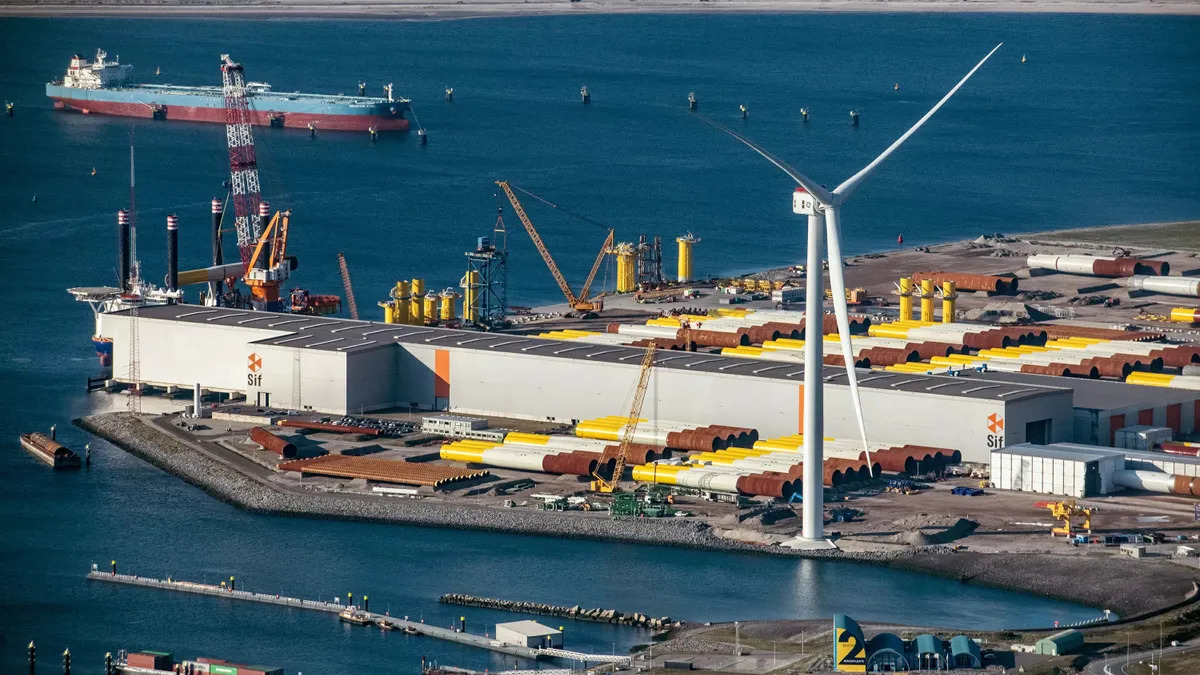Dive Brief:
- The nascent offshore wind industry in the U.S. must install at least 2,100 turbines and foundations in order to meet federal deployment targets, according to a report from the National Renewable Energy Laboratory released on Monday.
- Besides installing the turbines and building out a workforce, the U.S. must also build 6,800 miles of cable that must be laid underwater in order to achieve 30 GW by 2030, a goal set by the administration last year. To install the large fixtures, NREL says the offshore wind industry will need five to six wind turbine installation vessels, which must carry the U.S. flag to conform with the Jones Act. One such vessel is currently under construction.
- The Department of the Interior (DOI) is moving forward with a plan to expand leasing for offshore wind, with an auction planned for May in the Carolinas. DOI officials on Tuesday said at an industry conference that an auction will be likely held in the fall for leasing off the coast of California.
Dive Insight:
Wind turbine installations are already underway in federal waters: Dominion Energy completed its 12-MW pilot program off the coast of Virginia in 2020, and is working on approvals for a larger project for 2.6 GW.
NREL said 30.1 GW of offshore wind is expected to be installed in the U.S. by the end of 2030, meeting the Biden administration's goals.
But meeting that level of deployment is largely linked to the development of a domestic supply chain, analysts say.
"If a domestic supply chain is not developed in time, bottlenecks in the global supply chain will present a significant risk to achieving the national offshore wind energy target," NREL said.
As projects begin to ramp up, many states in the Northeast have to grapple with being ready for the manufacturing activities that include the assembly of very large pieces and laying underwater cables, NREL noted.
Per the report, existing East or West Coast ports largely lack sufficient capabilities to fully support offshore wind energy activities, prompting several ports to invest in infrastructure upgrades. States along the East Coast are encouraging development of manufacturing ports that can handle the weight and size of offshore wind project components. For instance, Maryland's offtake agreements for offshore wind stipulate that developers will invest in component manufacturing facilities.
The first phase of the NREL study was crafted using input from states that are working on encouraging offshore wind development and industry groups such as the U.S. Business Network for Offshore Wind.
"This collaborative study between DOE, NREL, states, and wind industry partners shows that we have significant opportunities to scale the development of a nascent offshore wind industry in the United States and greatly expand domestic manufacturing," Kelly Speakes-Backman, principal deputy assistant secretary for DOE's Office of Energy Efficiency and Renewable Energy, said in a statement.
However, plans for utility-scale offshore wind projects are causing some to balk at the high fixed costs. On Friday, the Virginia Attorney General's Office filed testimony on behalf of its Division of Consumer Counsel saying that the 180-turbine offshore wind project planned by Dominion will be two to three times more expensive than solar energy and is not needed for the utility's capacity. Virginia has a clean energy mandate in place encouraging renewable energy development, but the recent testimony said the $9.8 billion project posed "significant risks" to customers and that its economic benefits were overstated.
In response, Dominion spokesperson Jeremy Slayton told the Richmond Times-Dispatch that "offshore wind is good for energy security and the Virginia economy and environment."
As developers work to provide lower costs, industry groups are tracking the growth of the domestic supply chain.
The second phase of the NREL study will help identify pathways to build the domestic supply chain to meet the industry needs identified in the first phase.
The study will analyze ways to grow out the existing supply chain, as reported in the Business Network for Offshore Wind's national supply chain database. NREL will develop future domestic supply scenarios based on the location of existing suppliers, achievable time frames and the cost of new facilities. The analysis will also evaluate the potential impact of new supply chain efforts on underserved communities according to energy justice metrics that NREL is currently developing.















